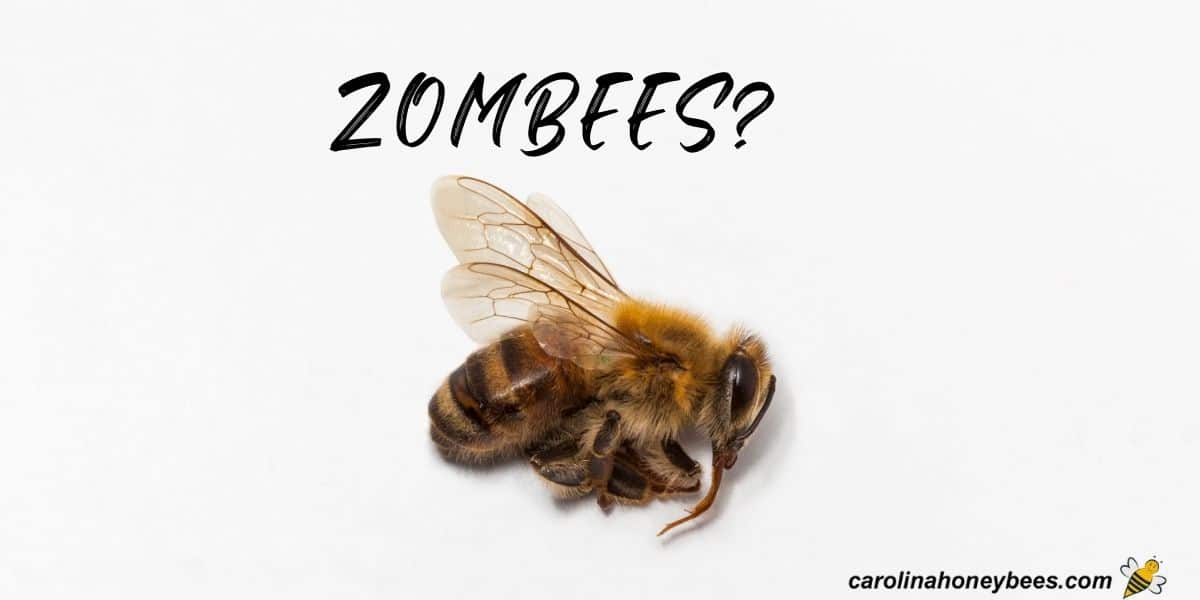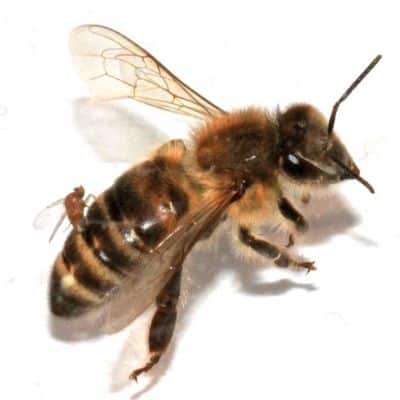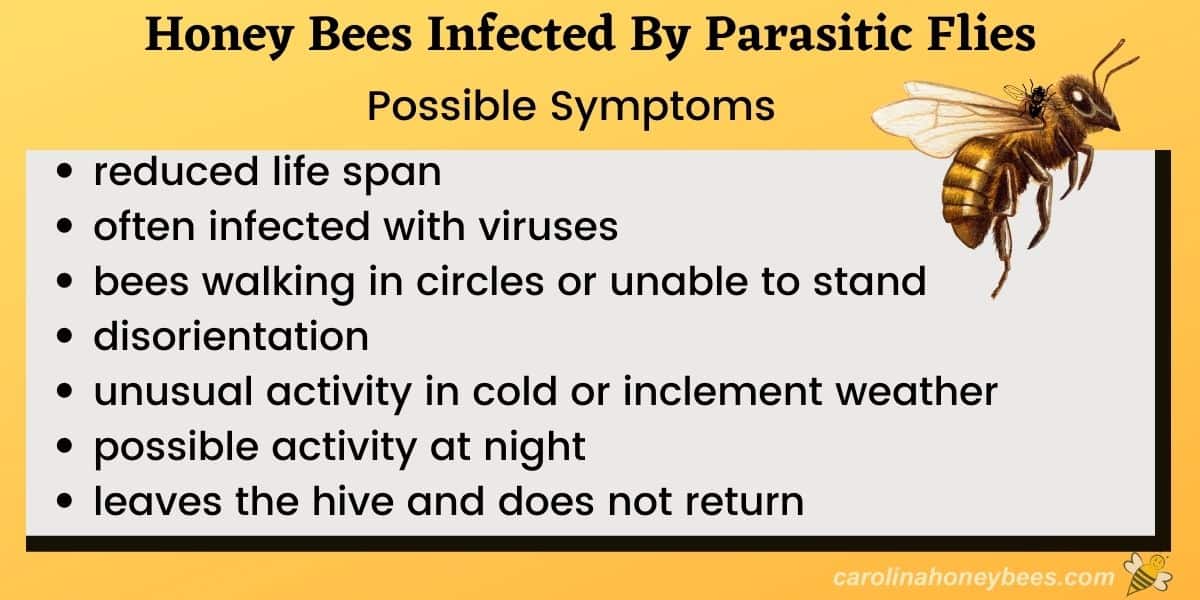Zombie Bees
As if honey bees don’t have enough challenges, a new threat has emerged in recent years. I am referring to the condition known as “Zombie Bees” (also called Zombees). These infected bees exhibit strange behaviors that ultimately lead to their death. The cause of this infection is a small parasitic fly (Apocephalus borealis). This article explores the basics of the phenomenon and helps beekeepers know what to look for.

As a Master Beekeeper, I learned early on that success depends on keeping up with new challenges and threats to our bees. You can’t simply learn it all and sit back. There are always new honey bee pests and diseases that you need to know about.
What are Zombie Bees?
The term “zombie bees” refers to honey bees that have been parasitized by the phorid fly, Apocephalus borealis.

First noticed along the West Coast of the US (2008), researchers began to look for a cause for some strange bee behavior patterns.
The infected bees would leave the hive at night and fly in circles until they died (zombies come out at night – right?). Scientists found this behavior was a result of the parasitic fly’s activity.
How Infection Happens
The process begins when the parasitic fly targets a honey bee. The female uses her ovipositor to inject eggs into the bees abdomen. This happens so quick that the bee may not even realize it.

Parasitic Fly Life Cycle
The fly eggs hatch into larvae and begin feeding on the bee from the inside out – digesting tissues and organs. Fly larva feed over a period of about 7 days.
Naturally, the health of the infected bee continues to deteriorate. As the larvae grow, the nervous system of the bee is affected – resulting in the jerky, erratic behaviors.
In the later stages of infection, the host honey bee becomes increasingly agitated. She is also attracted to light at night and will fly from the hive. (We don’t know why.)
When the fly larvae have completed their growth cycle, they will leave the bee’s body and pupate elsewhere for about 28 days. Up to 15 fly larvae may emerge from a single honey bee!

Symptoms of Infected Bees
These are some of the symptoms associated with zombie bees.
- erratic flight patterns
- leaving the hive at night
- infected bees abandon the hive
- disorientation
- larval emergence
First noted in California around 2008, John Hufernik, became aware of strange honey bee behavior. He was finding dozens of dead honey bees near outside lights each morning. Seeing some bees below an outside light is no surprise but the number of dead was concerning.
In these cases, the bees would hover around the light until they die. Therefore, you might find a small pile of dead bees at the base of a lamp post.
Even more puzzling, this was happening even on cool frosty mornings. And, we know that honey bees are insects – being cold blooded they are not normally out in cold temps.
Honey Bees Don’t Normally Fly at Night
Honey bees travel great distances for their size. They also move towards light – it attracts them.
But, it is unusual for honey bees to fly at night. Other than some sightings of foraging on full moon nights in warm weather -most forager bees stay home during the dark hours.
Bees use UV and polarized light to navigate, their tracking systems do not function well in the dark.
Of course, bees will leave the hive if disturbed by a predator after dark. This is why you don’t want to be the one holding the flashlight when moving bee hives at night!
Leave the Hive Never to Return
West Coast researchers and beekeepers noticed honey bees leaving the hive to gather at nearby lights at night. Not the total population of the colony, but many individuals would leave.
After flying to a visible light source (even if it was not in the close to the hive), the bees would buzz around the light until they died. There were reports of disoriented dying bees crawling on the ground under the light at dawn.
Somewhat like a “zombie that staggers around after dark – never to return to their home”. This is where the term “Zombee Bees” originated.
Disorientation
Infected bees may show disorientation, walk in circles or have an inability to stand. This could be observed inside the hive, on the ground outside on at the hive entrance.

Should Beekeepers Be Concerned
Does this mean you will see thousands of freaked out bees flying around at night? Before you go running to grab a silver bullet, wooden cross or garlic necklace, let me explain a bit more.
Apocephalus borealis is not a newcomer to the United States. In fact, it is native to most of North America. Smaller than a fruit fly, it was previously known to prey on bumble bees.
Honey bees have not been a known host in the past. This discovery confirms that they can infect honey bees. Has this been going on for a long time or is it a new development? We do not know.
Monitoring
I spend a lot of time in my bee yard, monitoring and performing varroa mite treatments – watching for problems that could affect my bees. Unfortunately, there is nothing the beekeeper can do to protect honey bees from parasitic flies.
Thankfully, not every bee in the colony will become one of the Zombee bees. This gives us hope that a strong colony will not fail due to infestation.
At this time, researchers do not know what role zombie flies play in colony failure. But you can help with the research endeavors by monitoring conditions in your hives.
Community Watch
A citizen scientist project is tracking the spread of Zombie bees. Following their website directions (zombeewatch.org), construct a light trap. These are simple to make with such items as a plastic jug and safety light using a compact fluorescent bulb.
Do you see honey bees flying around lights at night? You may notice the unusual activity of them at windows of your home when the lights are on inside.
Don’t place the light trap close to your hives – they should be well away. You do not want the light to shine on the entrance of the hives. You may encourage bees that are NOT Zombies to come out.
Any bees that you catch should be collected with tweezers or forceps – don’t touch them. Be careful dying bees can still sting. Transfer the dead bees into a sealed container and place away from the sun.
Check periodically for small brown pill shaped pupae inside the bottle or jug. They look like small pieces of brown rice to me. The pupae should appear between 5-14 days after collection. In another 15-28 days you may see flies.
Report your data to the watch program. It is important to their research to learn your results whether positive or negative.
My Experience
A few years ago, I had some honey bees wanting to visit our backyard lights at night. Not a lot but maybe 10-12. I decided to collect some of the dead bees and try to look for pupa.
Thankfully, I never noticed any fly pupa or flies. Perhaps, some of my bees just liked to party at night.
FAQs
The larva of the parasitic fly (Apocephalus borealis) develops into the body of a honey bees. Damaged caused to the nervous system of the bee causes erratic behavior.
No, the parasitic fly does not prey on humans. It will only lay eggs on or inside insects.
Infected bees may show disorientation, walk in circles or have the inability to stand. They fly erratically and stagger around at night like zombies.
Yes, though normally a bit confused and less aggressive – infected zombie bees can still sting.
A Final Word
Will this honey bee pest become a major killer of honey bee colonies? Will it be another “mite-type” issue that beekeepers must struggle to control? We don’t know how big an effect this parasitism has on a bee colony.
Beekeepers need to be aware of the problem but not overly dramatic. Researchers continue to study the problem and you can help.
There are many parts of the United States still in need of monitoring. This is a great opportunity to help the beekeeping community. And, it is open to beekeepers and non-beekeepers.

